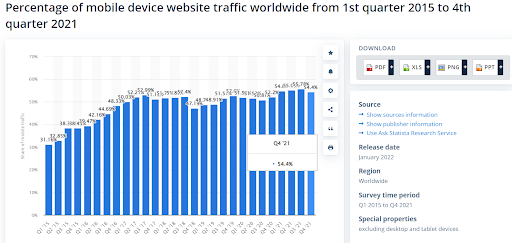A B2B ecommerce business caters to people within a company who have buying power and need to make purchasing decisions for their company. It also caters directly to businessmen and entrepreneurs. In a B2B transaction, clients tend to be more cautious about online purchases as it usually involves higher investment.
For these reasons, you will find that many B2B sites are not as flashy or consumer-friendly as regular eCommerce sites. They need to focus on providing information that helps potential customers understand why they should buy from them instead of another site.
So, B2B eCommerce best practices are focussed on providing information that helps businesses make purchasing decisions. If you are developing or running a B2B eCommerce platform, you need to keep these best practices in mind:
#1. Implement an Intuitive Catalog Navigation

Source: Adobe
A B2B enterprise works on a gigantic level of product & its variation. A big part of B2B eCommerce best practices is how easy it is for customers to find what they want.
An extensive catalog doesn’t mean much if customers can’t easily find what they want. So, optimization plays a vital role in creating an easy-to-use online shopping experience.
You can also map out a clear and easy-to-follow process to help customers know what to expect from your business. It can be especially important for complex products, such as custom orders or special requests.
To avoid confusion, ensure your catalog has a consistent and logical layout so it’s easy for customers to use on every device. The hired dedicated development team must ensure that it is easy for customers to find what they want, no matter how many products are available in your catalog.
The team can leverage color-coding consistently throughout the site, from product images and titles down to buttons and links in your navigation bar. Another effective method is using many filters to allow customers to search for products by different attributes and include as many filter options as possible. It will allow them to narrow down their search results quickly and easily.
#2. Create Engaging Product Content
Content is king, but for your website to be seen as a trusted source by consumers, you must provide them with meaningful and valuable content. Notable B2B eCommerce websites like Alibaba offer product information, including images, videos, reviews, and other detailed product specifications.
The digital content should match the physical products and their packaging. E-commerce websites that offer rich product content are more likely to have better conversion rates than those that do not.
Businesses need to keep up with clients’ expectations by providing as much information as possible about their products and services. A website should effectively and straightforwardly display all the information so that customers can easily find what they are looking for.
It helps them make informed decisions, thus increasing conversion rates and revenue. Some of the critical factors to look for while creating product content are:
1. Display all the color combinations available with the product
2. Rate as per to order quantity
3. Display all related products that can be purchased with a single click on any product
4. Showcase all relevant information about shipping and returns and delivery options available for each product being sold
5. Leverage videos, images, or even a 3D view of a product to provide customers with an immersive experience while shopping online for products or services offered by your business.
#3. Quick Reordering Should be Available

Source: Statista – Mobile Internet Traffic
One of your most important tasks is ensuring customers can reorder what they bought from you. It doesn’t only prevent frustration but also creates recurring revenue streams for your business. If customers take more than three clicks to get back what they ordered, you’re losing potential sales and revenue.
Reordering on B2B eCommerce websites should be easy. If customers have to search for a product, they’ll give up and go elsewhere. They’ll move on if they can’t find what they want with a few clicks.
If customers have bought a product from you before, it should be available for reordering with a single click. If they have to go through several steps, you’re losing sales.
#4. Ensure Mobile-Friendly Designs

Source: Statista – Mobile Internet Traffic
More than half (53 percent) of U.S. internet users shop on a mobile device, so businesses need to keep their mobile shopping experience up-to-date. According to Adobe, 56 percent of visitors abandon a site if it takes more than three seconds to load.
It may be surprising, but as much as 70% of B2B eCommerce searches occur on mobile phones and tablets. So, companies must have a solid mobile presence. Make sure your site is fully responsive and optimized for speed, and you’ll reduce your abandonment rate significantly.
In addition, your website should also be accessible across all devices, including desktop computers, laptops, smartphones, and tablets. It will help you engage with customers.
Final Suggestion: Design & Develop a B2C experience for your B2B customers
A B2B eCommerce website can learn and implement from the B2C websites. It will help you create a better user experience for your business customers and generate more leads for your business. After all, the ultimate user experience is all about providing intuitive design and useful features.
When it comes to driving sales, UX plays a critical role. You have to offer an intuitive and seamless shopping experience for your customers. You’ll lose out on potential customers if you can’t do that.
You need to focus on improving your customer experience as a business owner. It helps you build trust with your audience and drive more conversions in the long run.
Here are some best practices an eCommerce Development Company in India can implement to help improve your B2B website:
1. A/B testing is a method used for optimizing conversion rates and increasing sales. You can use it on your landing pages, product pages, checkout process, etc. By testing different elements on your website, you can find out what works best for your audience and improve their shopping experience.
2. To boost sales, you need clear calls to action on your landing and product pages. Without CTAs, your users won’t know what action to take on your website, which could lead them away from converting into a lead or a customer.
3. Product images are an essential part of your online store. If you want to improve your conversion rates, you need to have high-quality product images on your website. That way, users can view what they’re buying and make a decision accordingly. They’ll also be able to share it with their friends on social media, which can help you gain more exposure for your brand.
4. Augmented Reality (AR) helps you make your brand more relatable to your audience and give them a better idea of what they’re buying before purchasing it. You can use AR on your product pages, landing pages, etc. so that users can view their products in different environments before deciding whether they want to buy them.



